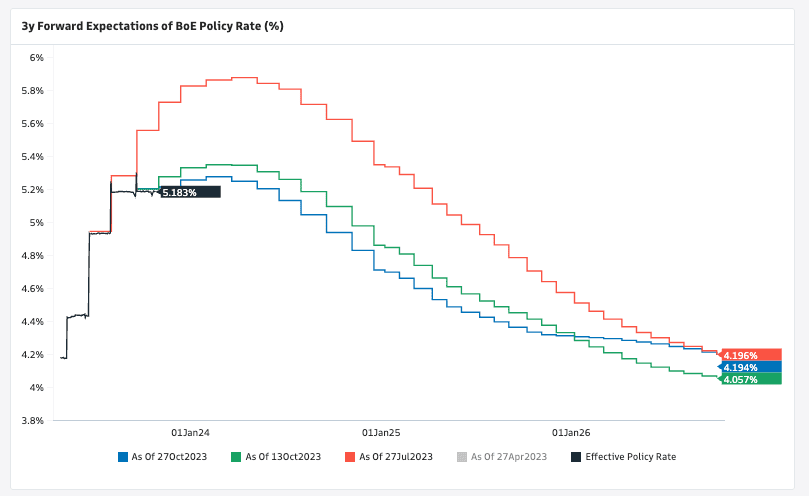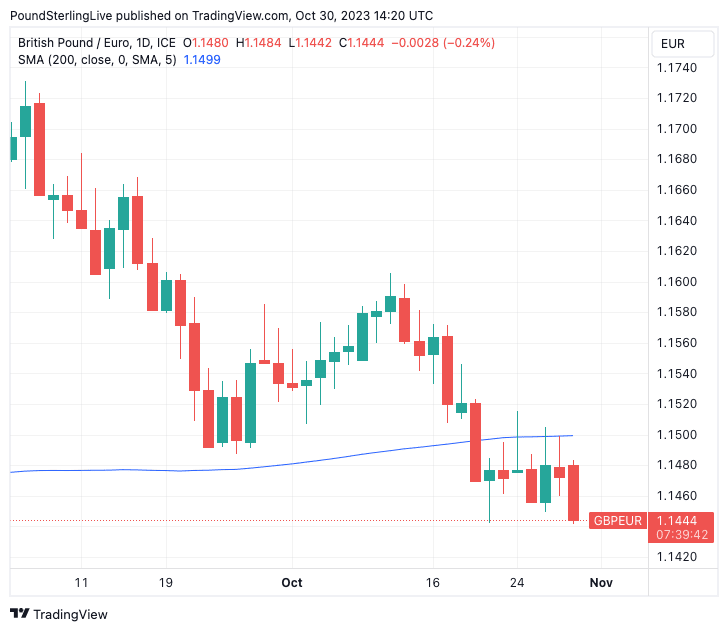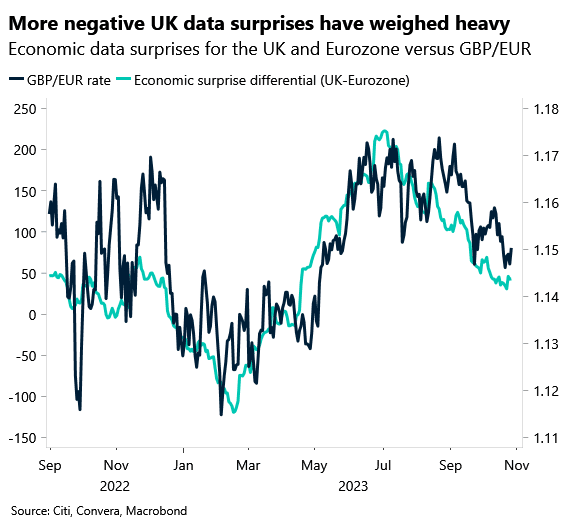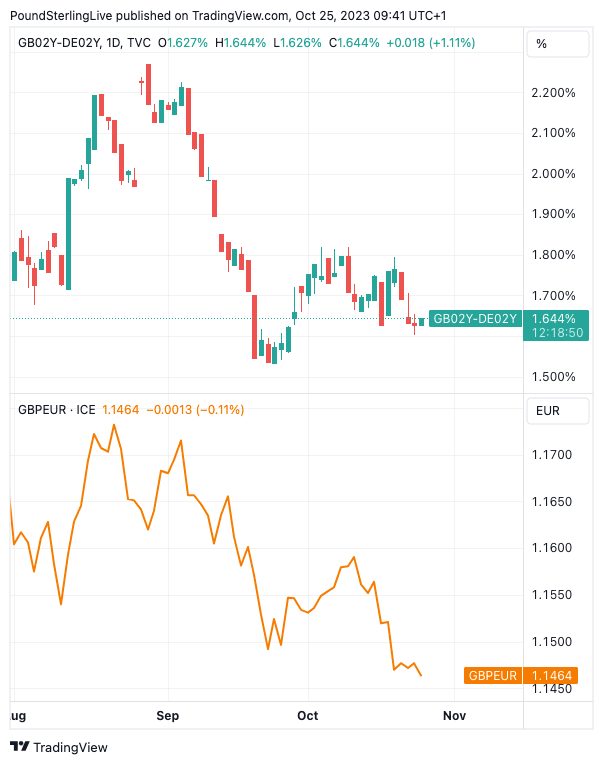Why the Pound is Falling Against the Euro
- Written by: Gary Howes

Image © Adobe Images
Why is Pound Sterling falling against the Euro, and can it right itself and recover to the levels seen earlier in the year?
This is the most prevalent question the editorial team at Pound Sterling Live has been fielding over recent weeks, particularly given the uninspiring Eurozone economic outlook and a widely held expectation the European Central Bank has completed its interest rate hiking cycle.
In answering this question, we believe three issues should be considered: first, the Pound to Euro exchange rate remains under technical pressure, with rebounds capped by the 200-day moving average, a resistance level which could prove difficult to break.
Secondly, yield differentials with Germany have been falling and are flat, and will need to rise again if GBPEUR is to rally.
Thirdly, negative economic surprises continue to act as a fundamental headwind.
"One area of surprise lately has been the downtrend in GBP/EUR. The currency pair has drifted into the bottom 10% of its 3-month range, breaking south of €1.15 (its 2023 average) and remains bearish below its 200-day and week moving averages," says George Vessey, Lead FX Strategist at Convera.
Compare Currency Exchange Rates
Find out how much you could save on your international transfer
Estimated saving compared to high street banks:
£25.00
Free • No obligation • Takes 2 minutes
From a fundamental perspective, Vessey notes economic surprises have been underwhelming in the UK relative to the Eurozone of late and there is clear evidence this is having a direct impact on the exchange rate.
For sure, sentiment towards the Eurozone is poor, but in the FX game, it is performance relative to expectations that count, i.e. expectations towards the Eurozone might have reached 'peak pessimism', whereas that might not be the case for the UK.
Above: GBPEUR is banging its head against the 200-day moving average, which is proving to be a notable technical barrier, according to analysts. Set up a daily rate alert email to track your exchange rate OR set an alert for when your ideal exchange rate is triggered ➡ find out more.
Vessey explains that economic surprise differential does not currently favour the Pound: "markets may be coming around to the fact that the UK economy is struggling much like Europe and recession risks are on the rise."
He presents the following chart, which provides evidence that economic surprise indicators are consistent with a softer Pound-Euro rate:
Image courtesy of Convera.
For the Pound to recover, it will simply require UK data to start beating expectations again, which would firm up expectations for UK interest rates.
Markets are particularly focused on the prospect of interest rate cuts from the Bank of England in 2024; the Pound comes under pressure when these expectations come forward.
Firmer data pushes back against these expectations and can therefore offer Sterling some support.
With this in mind, bond yields are also playing a significant influence on the Pound-Euro's performance as the yield on a key UK bond has been falling at a faster rate than on Eurozone equivalents since August.
This means the attractiveness of UK bonds relative to those of the Eurozone is falling, lowering demand amongst investors to convert euros into pounds in order to fund exposure to the higher-yielding UK bond.
This is known as the carry trade, and analysts say it is currently highly relevant to currency markets.
A look at the following chart comparing the difference between the UK two-year bond yield and the German equivalent offers a useful explainer:
What we see is the UK's advantage over Germany in the yield stakes is falling (lower panel), although it has stabilised of late, equating to the sideways move in GBPEUR over recent days.
As long as the fall in UK yields outpaces those of Germany, the GBPEUR can stay under pressure, but what can it take to reverse the situation?
Bond yields reflect future interest rate levels at the relevant central bank. Declining UK bond yields suggest the market is lowering its expectations for future Bank of England policy rates.
Specifically, the peak in the current hiking cycle is judged to be lower than it was, and rates will be lower in the future:

Image courtesy of Goldman Sachs.
The above shows that since July Bank Rate expectations in the market have fallen considerably, a development that coincides with falling UK bond yields and a softer Pound.
For UK yields to firm enough to boost the Pound, investors must believe the Bank of England will keep interest rates elevated for an extended period
This makes Thursday's interest rate decision and accompanying guidance important. Markets are already anticipating rates to be left unchanged and for the Bank to maintain guidance that rates will stay at current levels for an extended period.
But the Bank has proven to be a 'reluctant hiker' and has tended to err on the dovish side, and if it does so again on Thursday, markets could bring forward rate cut expectations, adding further pressure on UK yields and the Pound.
Compare Currency Exchange Rates
Find out how much you could save on your international transfer
Estimated saving compared to high street banks:
£25.00
Free • No obligation • Takes 2 minutes







